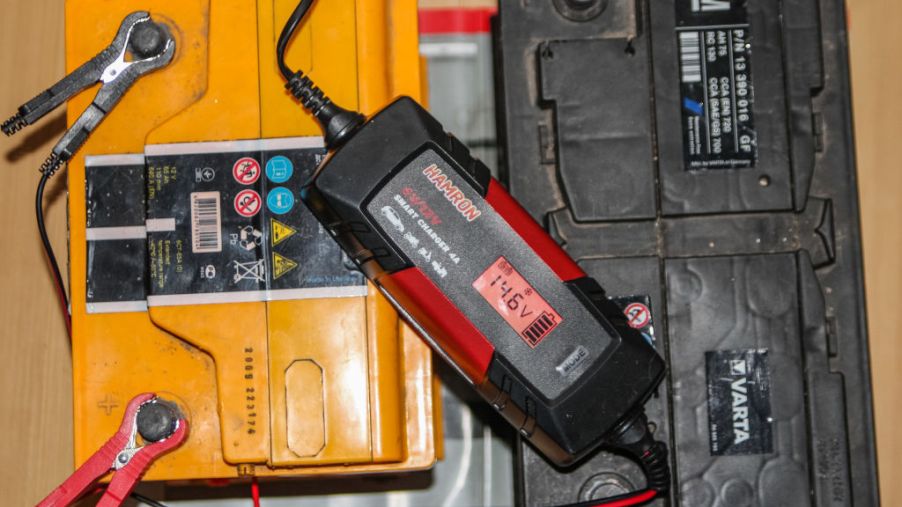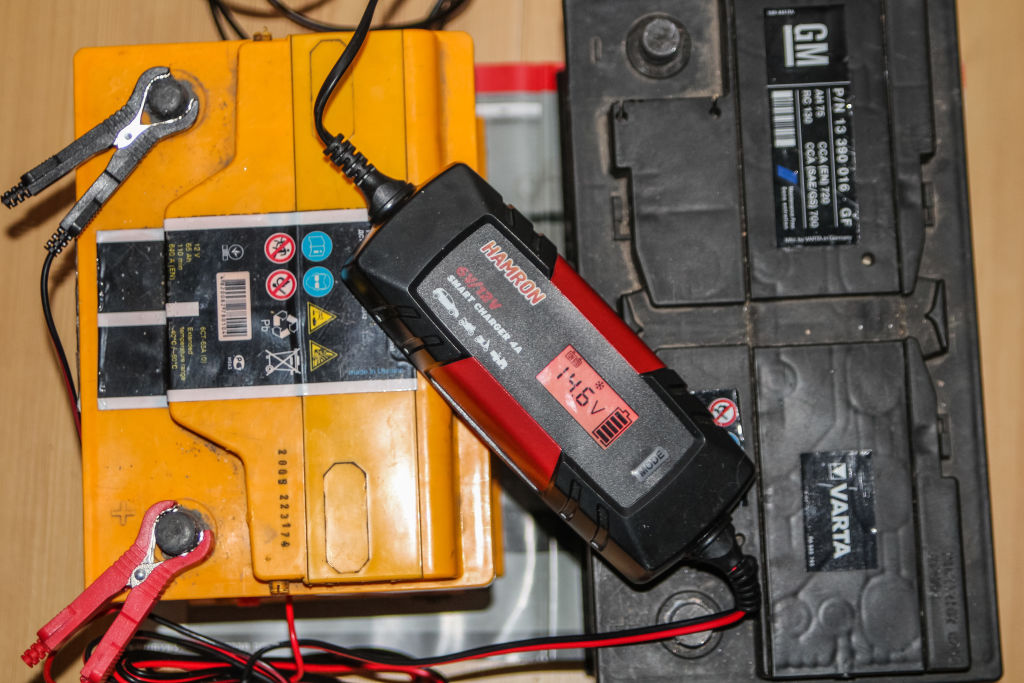
How to Keep Your Car or Motorcycle Battery From Going Flat
Regardless of how it happens, sometimes your vehicle can sit idle for an extended period of time. Usually, that’s to protect it from winter’s salt. However, if done improperly, just parking your car or bike can actually damage it. And one of the earliest casualties is your car’s or motorcycle’s battery. However, at its core, an ICE vehicle’s battery isn’t terribly different from an EV’s. Which means, there are ways to prevent it from going empty.
Keeping your car or motorcycle battery charged

The easiest way of keeping your car or motorcycle battery charged, The Drive reports, is to invest in a battery maintainer, aka a battery tender. While there are several types of battery maintainers, they’re all essentially plug-in chargers for your vehicle’s battery. Note, though, that some vehicle batteries—specifically, lithium-ion ones—require chemistry-specific chargers, Revzilla reports. Also, the battery has to be removed before being hooked up, as minor electrical grid fluctuations could fry the vehicle’s electrics.
The simplest battery tenders are actually just like the charger that comes with your laptop or phone. Although very inexpensive, recharging a car battery isn’t like recharging an iPhone. It’s extremely easy to over-charge the battery. Because charging a battery is basically reversing a chemical reaction, Lifewire explains, if it’s done for too long or too quickly, it creates heat. This can lead to the risk of explosions and even fire.
The preferred minimum for maintaining a car or motorcycle battery is a trickle charger. As the name implies, trickle chargers slowly feed power into the attached battery. Not only does this save power, but it also reduces fire and damage risk. However, it doesn’t eliminate the latter risks altogether. That’s because most trickle chargers will still continuously supply power to a fully-charged battery.
Although the most expensive, a floating (or ‘float’) charger is the safest way of keeping a car or motorcycle battery healthy over a long period. Similar to an EV fast charger, float chargers use software and hardware to monitor a battery’s current state. Based on the level of charge, they then modulate how much electricity goes into it. But, unlike trickle chargers, float chargers shut off after the battery’s full. And they only turn on again if the charge drops below a certain level.
Jump-starting a dead vehicle
As with EVs, car, and motorcycle batteries are influenced by temperature. The colder it is, the faster they’ll lose charge. That being said, The Globe and Mail reports an ICE vehicle battery can sit for up to a month if no lights or accessories are turned on. However, some vehicles, especially high-end ones, are known to drain their batteries quicker.
Luckily, jump-starting a dead car battery is fairly straight-forward, Popular Mechanics explains, using jumper cables. First, start with the dead car and fully-charged car parked close together, everything turned off. Connect the positive (red) terminal of the dead car to the fully-charged one’s positive terminal. Then connect the black (negative) fully-charged terminal to an unpainted metal part of the dead car’s engine bay. Turn on the fully-charged car, and let it run for 5-10 minutes. Turn off the engine, and try to start the dead car. Once it gets going, let it run straight for at least 20 minutes, or go for at least a 5-mile drive.
Motorcycles can also be jump-started by cars, Revzilla reports. And the process described is exactly the same. Connect the positive terminals, and connect the charged battery’s negative terminal to an unpainted metal part of the bike’s chassis. However, car jumper cable clamps are noticeably larger than ones used for motorcycles, which can cause a short if the car clamp touches the bike’s frame.
And, if you don’t have another vehicle handy, Cnet reports, there are portable jump-starters available. These are essentially high-power battery packs with built-in jumper cables.
However, if you’re noticing that your car or motorcycle battery continuously loses charge, it may be time to change it. Or, it could be a sign of another mechanical fault.
When should I replace my car or motorcycle battery?
Car and motorcycle batteries can last for up to 6 or 7 years, though usually, they start to show signs of deterioration after 3-5 years, AutoZone reports. There are several signs your battery may be on its way out, Advance Auto Parts reports. One is an engine that struggles to start. Or, in addition to frequent jump-starts, if you notice your battery terminals are corroded. At that point, your car battery needs to be replaced.
However, your battery is only one part of your car’s and motorcycle’s electrical system. Although the battery starts the engine and supplies power to the accessory when the engine’s off, it gets recharged via the alternator. The alternator is also what powers the radio and lights when the engine’s running, not the battery. And to start the engine in the first place, the battery sends power to the starter. Note, that some classic bikes have a kick-starter, not an electrical one.
If you turn the key, and the starter kicks in, but the engine doesn’t, it’s likely you have a starter problem, not a battery one, Revzilla reports. And if even after putting in a new battery, your car dies, that’s an alternator problem, Advance Auto Parts reports.
Follow more updates from MotorBiscuit on our Facebook page.


